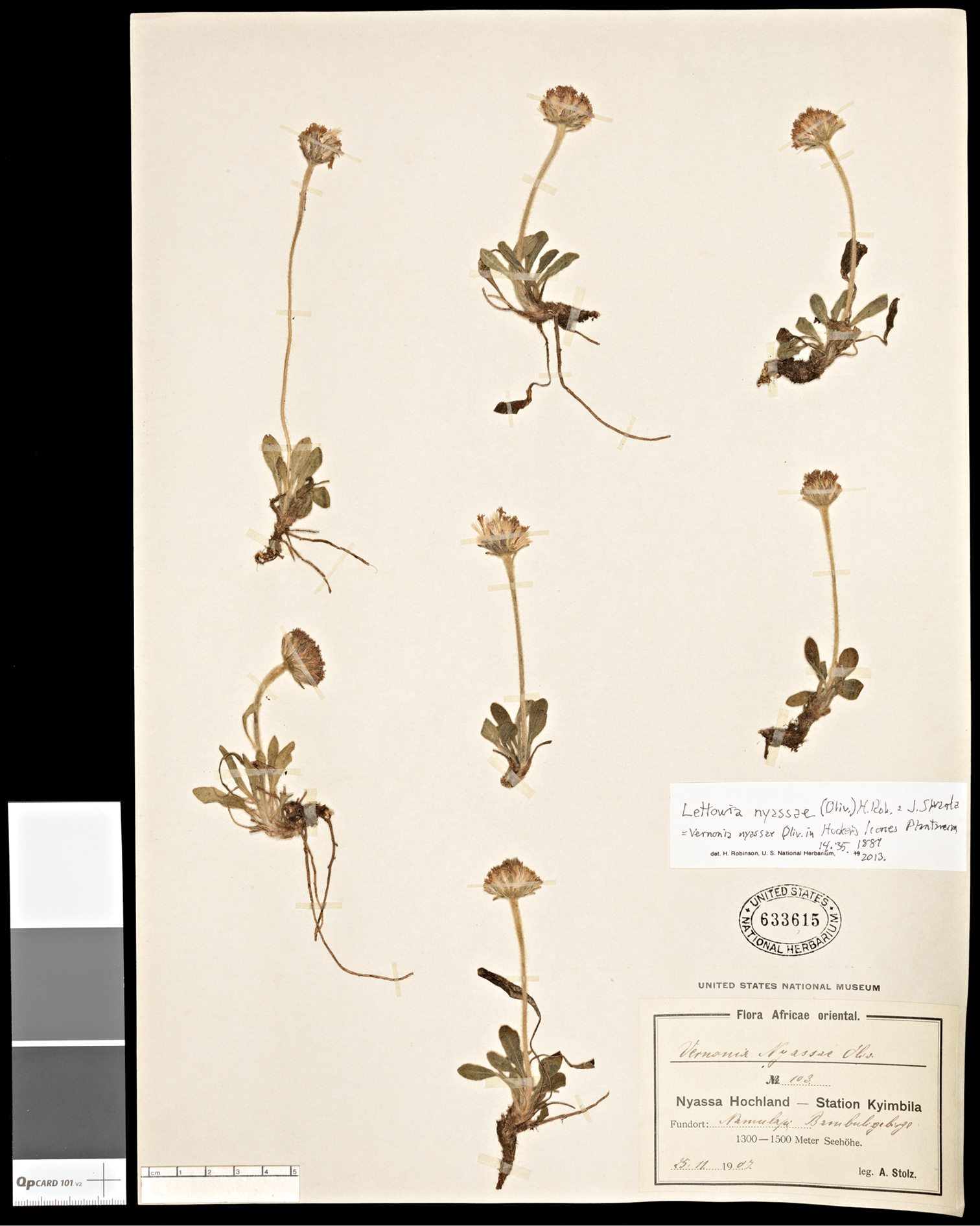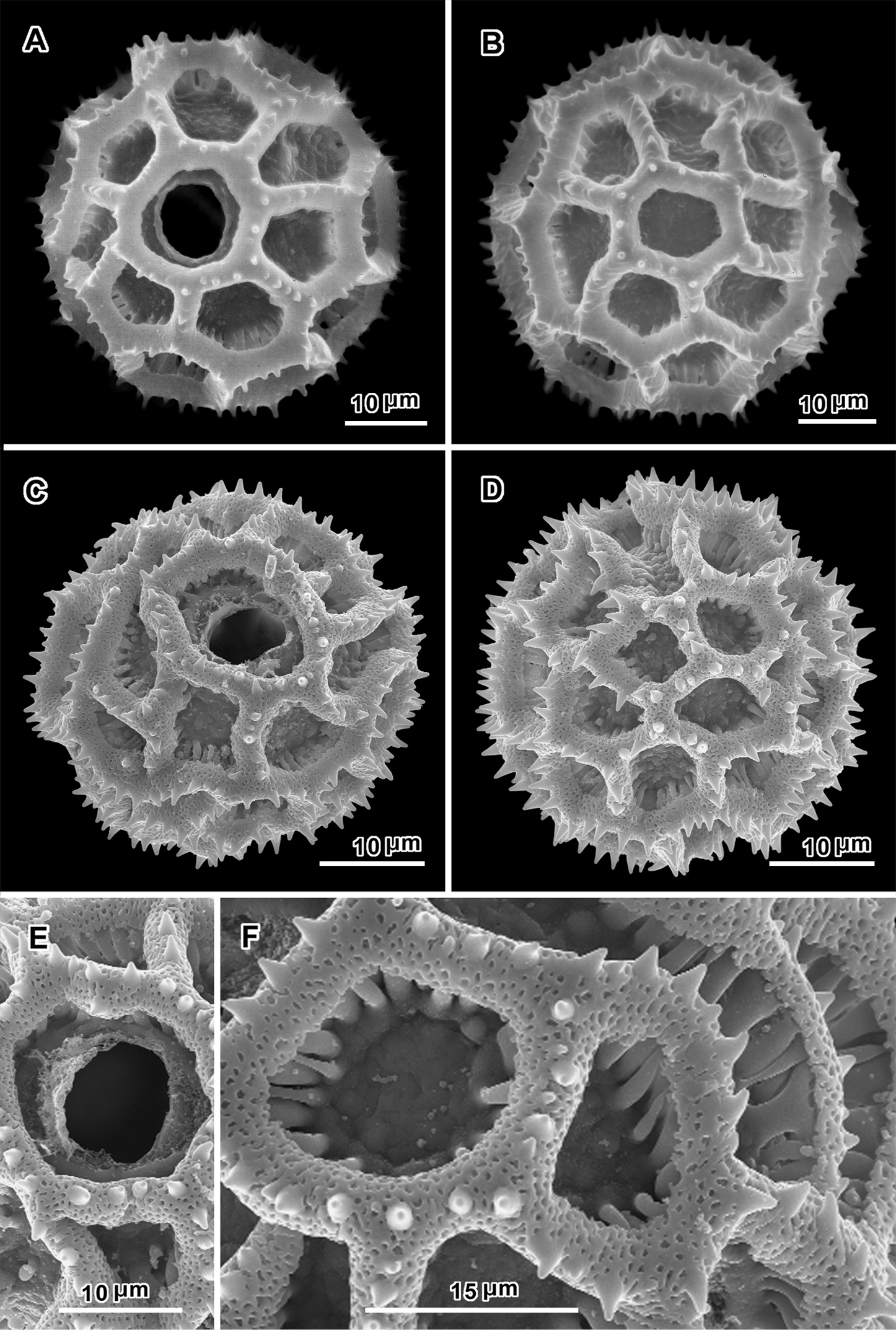






(C) 2013 Harold Robinson. This is an open access article distributed under the terms of the Creative Commons Attribution License 3.0 (CC-BY), which permits unrestricted use, distribution, and reproduction in any medium, provided the original author and source are credited.
For reference, use of the paginated PDF or printed version of this article is recommended.
Citation: Robinson H, Skvarla JJ (2013) Lettowia, a new genus of Vernonieae from East Africa (Asteraceae). PhytoKeys 25: 47–53. doi: 10.3897/phytokeys.25.5556
A new genus, Lettowia H. Rob. & Skvarla is named for the single East African species originally described as Vernonia nyassae Oliv. Its pollen is lophate and triporate, with a perforated tectum restricted to the muri. The new genus is placed near Vernoniastrum in the subtribe Erlangeinae.
East Africa, Lettowia, new genus, triporate pollen
Since Vernonia Schreb. is a strictly American and mostly eastern North American genus (
The present review includes a full description of the plant, including SEM studies of pollen, and a formal description of the new genus.
Pollen from dried buds was obtained from herbarium sheets at the U.S. National Herbarium in Washington, D.C. Detailed light microscope analyses under a Wild light microscope using oil and immersion optics were made of pollen in the dry condition as well as after immersion in Hoyer’s solution (
urn:lsid:ipni.org:names:77130232-1
http://species-id.net/wiki/Lettowia
Figs 1, 2A, BVernonia nyassae Oliv.
Erect or decumbent perennial herbs from creeping rhizome or perennial root crown, all becoming erect, rosettiform, with erect pedunculate scapiform inflorescence; hirsute or pilose with long white hairs, hairs of stems, leaves and peduncles with cells uniseriate and with few short basal cells and long, acicular, rather stiff apical cell. Leaves alternate in loose basal rosette, mostly 2–4 cm long, petiole narrow, blade obovate, to 9 cm long and 1.5 cm wide, apically obtuse, cuneate into petiole at base, margins entire, slightly paler abaxially, pilose on margins and both surfaces, more densely pilose abaxially, few glandular dots adaxially, numerous dots abaxially. Scape mostly 5–11 cm long, densely and stiffly hirsute, sometimes with small bract near middle, bearing 1 terminal head. Heads broadly campanulate, up to 2 cm high, 1.5–1.8 cm broad. Involucre with ca. 15–20 persistent, mostly subequal ovate-lanceolate bracts in ca. 2 series, up to ca. 1.5 cm long, apices acute, without acumination, densely pilose outside with long simple hairs, with 3 longitudinal veins, margins narrowly scarious, sometimes reddish. Receptacle epaleaceous; florets ca. 40 in a head; corollas lavender, ca. 12 mm long, narrowly funnelform distally from slender basal tube, tube ca. 7 mm long, with stalked narrowly capitate glands outside, throat ca. 0.7 mm long, lobes linear, ca. 4.3 mm long, with glandular dots outside and numerous stiff uniseriate hairs distally; anther thecae ca. 3 mm long, with tapering bases, with short clavate tails, apical appendage oblong, glabrous, with tenuous cell walls; style base with narrow annular node; with acicular sweeping hairs restricted almost completely to branches; achenes weakly 5-costate, densely sericeous on and between ribs with long setulae, setulae slightly split at tips, glandular dots present near base, without evident idioblasts, raphids linear; carpopodium narrowly annuliform, with small quadrate cells; pappus of ca. 40 persistent barbellate bristles ca. 8 mm long, mostly of even width, tapering at extreme tips, with outer series of short narrowly lanceolate squamae. Chromosome number not known. Chemistry not known.
Pollen grains of Lettowia nyassae (Fig. 2A, B) ca. 55 µm in diam in fluid, ca. 45 µm dry, echinolophate, triporate, muri shortly echinate with 2–3 spicules on each mural segment, perforated tectum restricted to the muri. The lacunae are irregular in position and rather irregular in shape. The baculae are elongate, in a mostly single partially unaligned series under each murus, and they are firmly attached to the footlayer. In these features, the pollen is nearly like that of Vernoniastrum (Fig. 2A, B), and the relationship to that genus in the subtribe Erlangeinae is assumed. In direct comparison with the single species of Vernoniastrum for which SEM study of the pollen is available (Fig. 2C–F), a number of subtle differences can be seen. In Lettowia, the lacunae are larger in general and less numerous (ca. 25–30 in Lettowia versus 35–40 in Vernoniastrum), the spicules on the muri are shorter and less numerous, and the baculae under the muri are mostly in a single row. In both genera there are lacunae that are elongate as if two lacunae are joined, but these do not seem to be aligned in positions where colpi might be located.
Herbarium specimen of Lettowia nyassae (Oliv.) H. Rob. & Skvarla (A. Stolz 103, US).
A–F SEM of pollen. A–B Lettowia nyassae (Oliv.) H. Rob. & Skvarla (A. Stolz 103, US) A View with a pore B Surface lacking pores C–F Vernoniastrum nestor (S. Moore) H. Rob. (Burundi, Prov. Burundi, Gihofi (Mosso), 20 May 1980, Reekmans 9185, US) C View with a pore D Surface lacking pores E Closer view of lacuna with a pore F Closer view of surface without pores showing extra rows of baculae.
The genus is named for Colonel Paul von Lettow-Vorbeck, 1870–1964 (
The genus contains the following single species.
urn:lsid:ipni.org:names:77130233-1
http://species-id.net/wiki/Lettowia_nyassae
Figs 1, 2A, BThe species occurs primarily in the area of southwestern Tanzania north of lake Nyassa, and also in eastern Zambia, Ndola, Oct 1906, C.F.E. Allen 363 (SRGH).
Tanzania, Nyassa Hochland, Station Kyimbila, Rmubya Braubuligebirge, 1300–1500 m Seehöhe, 25 Nov 1907, A. Stolz 103 (US).
Evidently in savannah areas.
We wish to thank the former technician Brian Kahn for preparation of the pollen samples of Lettowia nyassae, using facilities of the Palynological Laboratory formerly maintained by Joan Nowicki in the Department of Botany, NMNH, and Susan Braden is thanked for operating the NMNH SEM scope. W. Chissoe at the University of Oklahoma is thanked for preparation of the pollen of Vernoniastrum nestor. James Di Loreto, Smithsonian, National Museum of Natural History Imaging, is thanked for the photograph of the herbarium sheet.

